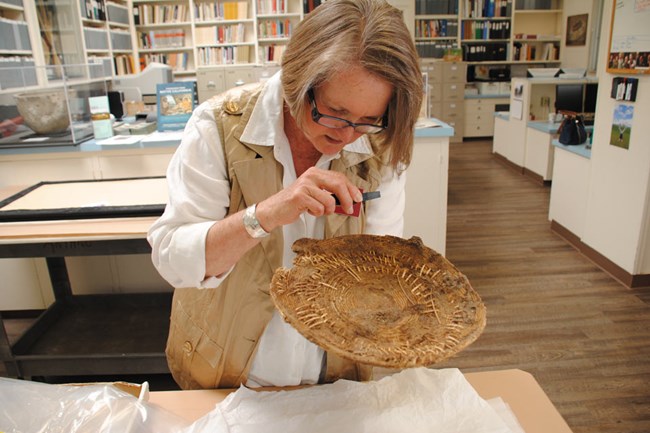
Chapter 5
Dr. Jan Timbrook, Curator of Ethnography, Santa Barbara Museum of Natural History, discusses plants the indigenous people of San Nicolas Island might have used for food and other purposes.
San Nicolas Island has fewer plant resources compared to the mainland, so food from the sea was important to the islanders. In order to survive, they needed to know where to look and what time of year they could collect seeds, fruits, leaves, and roots to supplement their mostly marine based diet.
For example, in early spring, miner’s lettuce and clover provided succulent fresh greens. Later on, seeds from grasses and wildflowers like fiddleneck and coreopsis could be collected, dried, and stored for future use. Starchy bulbs of blue dicks were dug up and roasted in pit ovens like little potatoes. They used the edible pads and juicy red fruits of the prickly-pear cactus—but the spines needed to be carefully removed first!
Most plants that mainland peoples used for making baskets, cordage (string), and tools were not found on San Nicolas, so the islanders found substitutes. Surf grass, a marine plant that looks like long green hair, was very useful. It was made into mats for sitting or sleeping on. It was also attached to a framework of driftwood or whale rib bones and used as roofing material for houses. Its strands were also twisted into cordage, which was then made into nets, bags, fishing lines, and even women’s skirts.
-
Listen to chapter 5 entry
Learn about how the native people on San Nicolas Island used island plants.
Chapter 18
Dr. Jan Timbrook, Curator of Ethnography, Santa Barbara Museum of Natural History, talks about the way indigenous people used various plants on the Channel Islands.
Karana would have made her skirt from surf grass, a marine plant that looks like long green hair and can be found in the tidepools around the island. The strands were rinsed, straightened, and partly dried before being woven into mats, twisted to make string, or made into women’s skirts.
Most likely, Karana’s skirt would have had a few rows of twined surf grass weaving at the top, with the other strands hanging loose like long fringe down to her knees. Karana might have molded small bits of soft beach tar around the ends of the surf grass strands that hung near her knees. These little weights would make the skirt sway softly when she walked.
Surf grass can only be made into flexible items, like bags and nets, not rigid containers. The only plant on San Nicolas that could be used as basket material is willow. Slender stalks of sandbar willow can be fashioned into openwork carrying baskets used when harvesting clams, mussels, or other shellfish.
It is possible that some baskets used by the Nicoleños, especially those used for boiling liquids with hot rocks, were obtained through trade with mainland peoples. George Nidever, who retrieved the Lone Woman from San Nicolas Island in 1853, watched the Lone Woman make water bottle baskets while they were still on the island.
-
Listen to chapter 18 entry
Learn about use of island plants for mats, string, skirts, bags, nets, and baskets.
Chapter 26
Dr. Jan Timbrook, Curator of Ethnography, Santa Barbara Museum of Natural History, talks about the indigenous use of medicinal plants.
For common, everyday ailments, Southern California mainland Indian people used widely known plant medicines. For example, they used the tea of willow bark for headaches or fever and elderberry flowers for colds. Yerba buena was taken for stomachache, yarrow used to stop bleeding from cuts, and yerba mansa for skin infections. Unlike today, most people did not get an itchy rash from poison oak. Instead of avoiding the plant, they used its juice to heal warts or persistent sores.
If these treatments did not work—if a person was seriously ill or if witchcraft was suspected—then a specialist would be consulted. There were several kinds of doctors whose goal was to restore the patient to harmony, thereby assuring recovery. The pipe doctor, for example, used tobacco smoke, along with singing and praying, as part of the treatment.
People on San Nicolas Island did not have access to many of the plants that mainland peoples used medicinally. They may have experimented to find local substitutes, received some medicines through occasional trade with other areas, or simply have gone without those remedies.
-
Listen to chapter 26 entry
Learn about the native islanders’ medicinal use of plants.
Last updated: June 1, 2018
